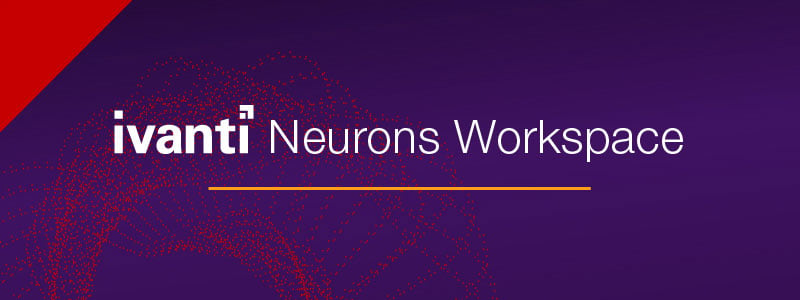Ivanti Neurons Workspace: Deliver Faster Resolutions Without Disrupting Your Customers
 When was the last time an IT conversation reminded you of the movie “Casablanca”? That happened to me recently when I was talking with another IT professional about Ivanti Neurons. We discussed how Ivanti Neurons will make life easier for IT by delivering more self-servicing, self-healing and self-securing experiences. He agreed Ivanti Neurons would be a big help reducing incidents but then said, “We’ll always have tickets.” Ok, maybe this isn’t on the same level as “We’ll always have Paris” but cue the Casablanca flashback.
When was the last time an IT conversation reminded you of the movie “Casablanca”? That happened to me recently when I was talking with another IT professional about Ivanti Neurons. We discussed how Ivanti Neurons will make life easier for IT by delivering more self-servicing, self-healing and self-securing experiences. He agreed Ivanti Neurons would be a big help reducing incidents but then said, “We’ll always have tickets.” Ok, maybe this isn’t on the same level as “We’ll always have Paris” but cue the Casablanca flashback.
He was correct, of course. End users will still have issues IT will need to resolve. But add rising expectations for better customer-service experiences, ideally resolving incidents without any disruption or escalation delays, and the demands on the first-line team keeps growing.
Helping the first-line team do more on their own is one outcome Ivanti Neurons Workspace delivers. IT teams using Ivanti Neurons Workspace are finding it’s helping them become more efficient and effective, and greatly reduce escalations by safely providing first-line teams with the required tools for more first-call resolutions, using automated tasks pre-defined by specialists, so they can resolve incidents faster and easier, and deliver great experiences to end users.
Ivanti Neurons Workspace augments IT teams by providing—in a ‘single pane of glass’—the real-time device and end-user insights provided by Ivanti Neurons for Edge Intelligence, with automation-powered bots for pre-defined actions, and also full remote control functionality for those times when IT just needs to reach out and take control.
Offering examples always helps me understand a new solution. Let me share a few where Ivanti Neurons Workspace has delivered better IT outcomes and end-user experiences.
“I was misinformed”
How often does your team start working an incident by asking the end user a bunch of questions to figure out what’s going on? Often the end user may not know the answers, or your analyst must guide them through the steps, especially now since ‘just stopping by’ isn’t an option these days. Or your analyst needs to use several tools to discover what’s going on, and you have a recipe for an engagement that may take a while before the end user is back to work and the analyst can move onto other tasks.
The ‘After’ picture with Ivanti Neurons Workspace is much easier. First-line analysts have immediate access to key IT information on users and their devices, such as:
- All associated devices for the user
- Device state, including running processes and services
- Active Directory status
- Group memberships
- Incident history by user or device
- Installed software, applications, and patches
- Network status
- Application connectivity
All this information and more is presented to an analyst in one screen, sometimes faster than if the analyst had the device in front of them. Add in the ability to ‘drill down’ into specific attributes, all without bothering or asking the end user to do anything. Your analysts will be a big step ahead in figuring out what’s going on and understanding the end user’s experience.
“Round up the usual suspects”
Quick insight is the first step to resolving incidents. Most incidents aren’t unique, so there are likely common actions a specialist could take to resolve incidents and requests. Ivanti Neurons Workspace safely provides many of these specialist-level actions to the first-line analyst within the context of an incident without providing full access. Such actions include:
- Resetting passwords
- Unlocking accounts
- Changing or assigning group memberships
- Flushing the DNS
- Updating drivers
- Stopping processes and services
These actions employ the same automation engine as used with Ivanti Neurons for Healing so the underlying workflows can likewise be updated, extended, or created anew to provide more automated actions to augment first-line analysts. If an incident isn’t one the first-line analyst can resolve, it can be escalated to a specialist with all the actions and diagnostic information logged.
One example is repairing a device encountering too many crashes or BSOD (Blue Screen of Death). Okay, one crash may be too many, but several is obviously too many. Either way, having the BSOD dump files helps IT diagnose the cause. A workflow in Ivanti Neurons Workspace could reach out to the device, get the needed files, compress them, and send them in an email to IT, all without bothering the end user or doing a remote session. The end user keeps on working while IT analyzes the dump files.
“Play it, Sam”
The extensibility of Ivanti Neurons Workspace means IT teams will be able to automate more and more diagnostic and remediation activities and make them more easily and safely available to first-line analysts. Your specialists can develop the automated actions the first-line team needs to resolve more issues on their own, turning escalations into first-call resolutions.
And with fewer escalations, specialists will have more time to conduct other investigations and innovations. Take the earlier BSOD example. Specialists could use Ivanti Neurons to see if other similar devices are having too many BSODs, identify those devices, analyze their dump files (again, without bothering end users), and see if there’s a common cause, like a device driver that needs updating. Oh, and that driver update? That can be automated with Ivanti Neurons Workspace as well.
“I think this is the beginning of a beautiful friendship”
Ivanti Neurons Workspace, along with the rest of the Ivanti Neurons solutions, promises to make IT more efficient and effective. Some IT teams are already seeing results such as:
- Deeper device and user insight in real time
- Faster issue resolutions
- Fewer escalations
- Quicker identification of problem trends
- Greater security compliance
And delivering more “Shift Left” outcomes and exceptional user experiences.
Learn more and see Ivanti Neurons Workspace in action here. Hopefully it’ll be the beginning of a beautiful friendship.

